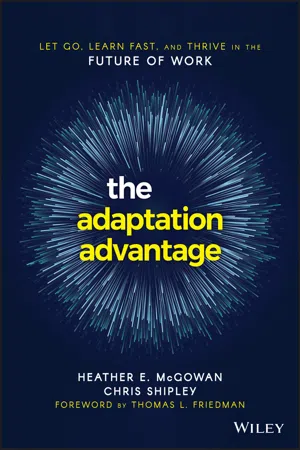
The Adaptation Advantage
Let Go, Learn Fast, and Thrive in the Future of Work
- English
- ePUB (mobile friendly)
- Available on iOS & Android
The Adaptation Advantage
Let Go, Learn Fast, and Thrive in the Future of Work
About this book
A guide for individuals and organizations navigating the complex and ambiguous Future of Work
Foreword by New York Times columnist and best-selling author Thomas L. Friedman
Technology is changing work as we know it. Cultural norms are undergoing tectonic shifts. A global pandemic proves that we are inextricably connected whether we choose to be or not. So much change, so quickly, is disorienting. It's undermining our sense of identity and challenging our ability to adapt. But where so many see these changes as threatening, Heather McGowan and Chris Shipley see the opportunity to open the flood gates of human potential—if we can change the way we think about work and leadership. They have dedicated the last 5 years to understanding how technical, business, and cultural shifts affecting the workplace have brought us to this crossroads, The result is a powerful and practical guide to the future of work for leaders and employees. The future can be better, but only if we let go of our attachment to our traditional (and disappearing) ideas about careers, and what a "good job" looks like.
Blending wisdom from interviews with hundreds of executives, The Adaptation Advantage explains the profound changes happening in the world of work and posits the solution: new ways to think about careers that detach our sense of pride and personal identity from our job title, and connect it to our sense of purpose. Activating purpose, the authors suggest, will inherently motivate learning, engagement, empowerment, and lead to new forms of pride and identity throughout the workforce. Only when we let go of our rigid career identities can we embrace and appreciate the joys of learning and adapting to new realities—and help our organizations do the same.
Of course, making this transition is hard. It requires leaders who can attract and motivate cognitively diverse teams fueled by a strong sense of purpose in an environment of psychological safety—despite fierce competition and external pressures. Adapting to the future of work has always called for strong leadership. Now, as a pandemic disrupts so many aspects of work, adapting is a leadership imperative. The Adaptation Advantage is an essential guide to help leaders meet that challenge.
Frequently asked questions
- Essential is ideal for learners and professionals who enjoy exploring a wide range of subjects. Access the Essential Library with 800,000+ trusted titles and best-sellers across business, personal growth, and the humanities. Includes unlimited reading time and Standard Read Aloud voice.
- Complete: Perfect for advanced learners and researchers needing full, unrestricted access. Unlock 1.4M+ books across hundreds of subjects, including academic and specialized titles. The Complete Plan also includes advanced features like Premium Read Aloud and Research Assistant.
Please note we cannot support devices running on iOS 13 and Android 7 or earlier. Learn more about using the app.
Information
Part I
Adapting at the Speed of Change
- In the midst of the greatest-ever velocity of change in technology, climate, and markets, we must become adept at adapting.
- Dramatic shifts in cultural and social norms are challenging our sense of personal and professional identity, and our ability to navigate the identity crisis is dependent on our ability to define, own, and embrace the fundamental aspects and values of our complex selves.
- The impact of technology on work can be alarming, but we have already begun to adapt. Our ability to continue to adapt with agility and without fear is fundamental to our future prosperity.
1
The World Is Fast: Technology Is Changing Everything and Planting Opportunity Everywhere
- We are in the midst of the greatest velocity of change in human history at the same time we are experiencing the greatest leaps in human longevity.
- Three “climate changes” are happening all at once, New York Times columnist Thomas Friedman tells us. These changes are happening to technology, the climate, and the market, and they are reshaping politics, geopolitics, community, ethics, and work and learning. This book focuses on work and learning.
- When everything starts shifting so quickly, we have to become adept at adapting.
Wait a Second

Technological Climate Change
Table of contents
- Cover
- Praise for The Adaptation Advantage
- Foreword: From Flat to Fast to Smart to Deep
- Introduction
- Part I Adapting at the Speed of Change
- Part II Letting Go and Learning Fast to Thrive
- Part III Leading People and Organizations in the Evolution of Work
- Additional Resources
- Acknowledgments
- About the Authors
- Index
- End User License Agreement